Smoke is toxic
Is Smoke Dangerous?
“For particles and ozone, it is possible to derive a quantitative relationship between the concentration of the pollutant as monitored in ambient air and specific health outcomes (usually mortality).” (Australian NEPM Review Discussion Paper 2010).
“There is no safe level of exposure to particle pollution. Over many years, exposure has similar long-term consequences to environmental tobacco smoke, including the risk of lung cancer and heart disease.” (Dr James Markos, Respiratory Physician and Chairman of the Tasmanian Branch of The Australian Lung Foundation).
The U.S. Environmental Protection Agency has determined that any length of casual exposure to particle pollution poses serious health risks, such as early death, cancer and cardiovascular and respiratory harm (American Lung Association).
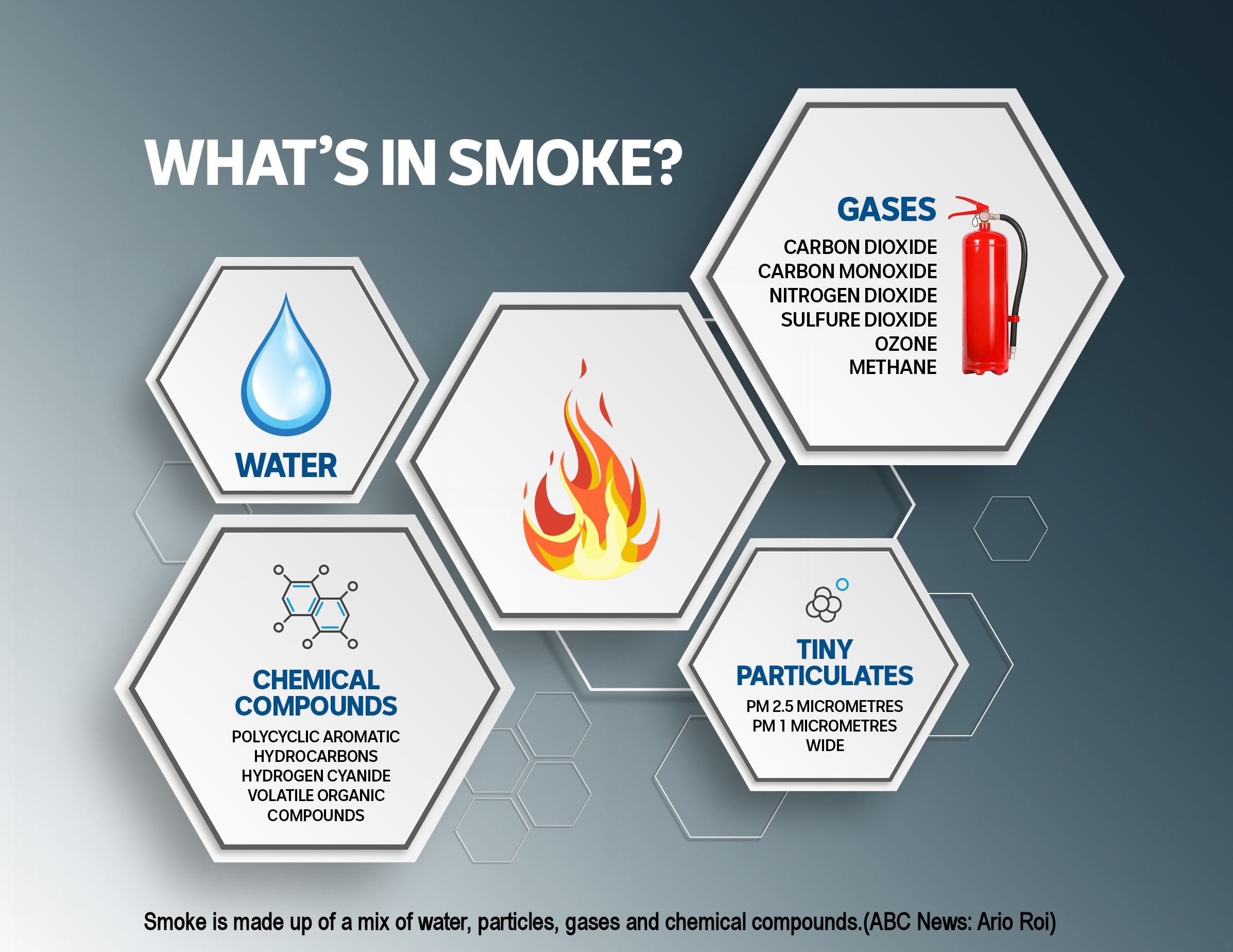
What's in Smoke
This is what you breathe. It goes into your lungs, crosses over into your blood stream and travels to every organ in your body. Particulate matter is a Group 1 (the highest) carcinogen, just the same as asbestos, arsenic, formaldehyde, and mustard gas to name a few other nasties.
Wood smoke is primarily made up of particulates, chemical vapours, and gases.
Chemical vapours and gases can come from the wood burning process or for example from chemicals applied to the ground.
‘Every single disease that is non-communicable is impacted by air pollution. It is not only involved in worsening diseases but in causing them, and new diseases, that wouldn’t otherwise occur are happening because of air pollution.’ and now COVID.
– Sir Stephen Holgate, Professor of Immunopharmacology and a respiratory physician
Exposure to forest fire smoke has been associated with increased respiratory symptoms (Aditama, 2000; Kunzli et al., 2006), increased COPD and asthma-related emergency room visits (Duclos et al., 1990), increased physician visits (Moore et al., 2006), and increased medication use (Kunzli et al., 2006
Air pollutants such as sulfur oxides, nitrogen oxides, and suspended particular matter (SPM) are known to CAUSE damage to health. These substances can CAUSE bronchitis, bronchial asthma, COPD and other respiratory diseases. (in Akira et al., 2004, Tropical Medicine and Health, 32 (4), 329-333)
Animal toxicology studies show that wood smoke exposure can disrupt cellular membranes, depress macrophage activity, destroy ciliated and secretory respiratory epithelial cells and cause aberrations in biochemical enzyme levels.” (3) A Summary Of Emissions Characterization And Noncancer Respiratory Effects Of Wood Smoke, Timothy V. Larson and Jane Q. Koenig, U.S.EPA-453/R-93-036, Dec. 1993)Fine particles easily bypass the natural filters in the nose and throat, penetrate deep into the lungs, and carry toxins further into the bloodstream.
The inhalation of particulate matter CAUSES asthma, upper and lower respiratory tract infections, COPD (chronic obstructive pulmonary disease), and Ischemic Cardiomyopathy (Dost 1991; Eeden 2001; Health Research Working Group 2001; Larson and Koenig 1994).
COPD is a progressive, life-threatening disease associated with tobacco smoking, air pollution or occupational exposure. (Novartis)
Health effects from particulate matter occur after exposures of 2-4 hours or less in duration of woodsmoke at the 12 – 29mcg/m3 range (Koenig et al. 1993)
“I saw very strong and significant associations between tonsillitis, frequent cough, pseudo-croup, exercise induced wheeze, food allergies and woodsmoke exposure in our school children. I think that Wood smoke is one of the most harmful air pollutants we have on earth.” (Gerd Oberfeld, M.D., Epidemiologist, Public health office – Unit for Environmental Health, Salzburg, Austria. International Study of Asthma and Allergies in Childhood,(ISAAC) Salzburg 1997.)
Fine particle concentrations are linked to adverse health impacts ( Dockery et al 1993, Pope et al 2002)
Particle pollution also has an adverse effect on all other life forms including plants.
Lung cancer and wood smoke exposure connection (Delgado J, Martinez LM, Sánchez TT, Ramirez A, Iturria C, González-Avila G).
A study by the University of Washington in Seattle showed that 50 to 70 percent of the outdoor levels of wood smoke were entering homes that were not burning wood.
Particulate matter is one of the most significant emissions from forest fires. Ninety percent of particulate matter in biomass smoke is PM10, meaning that it is 10 micrometers or smaller in diameter (EPA 1998; Ottmar 2001).
Wood Smoke is greater than 90% Fine Particulate Matter, ie, PM 2.5 or less. (American Lung Association).
“The majority of particles emitted from biomass burning, which includes controlled burning and uncontrolled fires, are ultrafine, with only a small fraction in the larger size range, and with most of the mass present in particles less than 2.5 um in aerodynamic diameter (WHO, 1999).”
Air quality. Carbon particles in the air from the burning of fossil fuels, wood, and other materials scatter and absorb UVB rays, diminishing vitamin D production.
Size distributions of particles generated from forest fire (vegetation burning).
Chart courtesy of the Australian Government/ Department of the Environment and Heritage
http://www.environment.gov.au/system/files/resources/00dbec61-f911-494b-bbc1-adc1038aa8c5/files/health-impacts.pdf
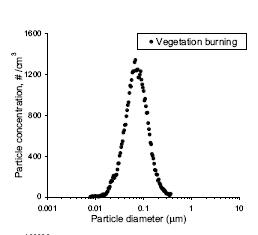
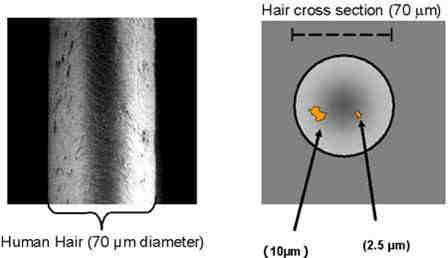
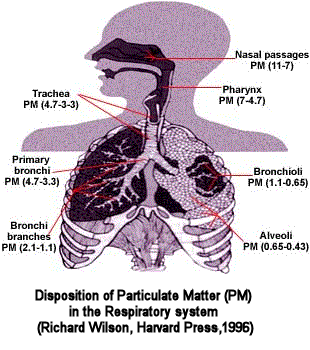
Fine particles easily bypass the natural filters in the nose and throat, penetrate deep into the lungs, and carry toxins further into the bloodstream.
The lungs are a pair of spongy, air-filled organs located on either side of the chest (thorax). The trachea (windpipe) conducts inhaled air into the lungs through its tubular branches, called bronchi. The bronchi then divide into smaller and smaller branches (bronchioles), finally becoming microscopic.
Studies show that reduced resistance to disease is linked, among other things, to wood smoke exposure. Smoke produced by wood combustion harms the cellular membrane, slows down immune system activity, damages the inflammatory cells that protect and clean the respiratory tract, and also disrupts enzyme levels. (Lung Assn. Quebec).
Smoke is a mixture of particles and gaseous chemicals of varying physical and chemical properties. When inhaled these produce the characteristic features of smoke-inhalational injury. Although heat is produced in fires it is the chemical agents which cause the damage to the airways and the lungs. Mortality and morbidity are closely related to pulmonary injury and thus to the particulate and chemical nature of smoke. Moreover, there seems to be a potentiating effect, in that the particles worsen the toxicity of the chemicals present.- I.R. Hill 1996. Department of Forensic Medicine, Guy’s Hospital, London, UK
Enlarged wood smoke particle taken from a human lung:
Original picture size 3 7/8 ” by 3 3/8″ at 900x enlargement.
Chest p.1232. Interstitial Lung Disease and Domestic Wood Burning, Ramage, Roggli, Bell and Piantadosi.
The wood smoke particle swells up inside the body.
It swells up inside the 99% humidity of the lung.
Growth is between 70% and 92%.
Higher loads of the combustion toxics are deposited directly into the lung.
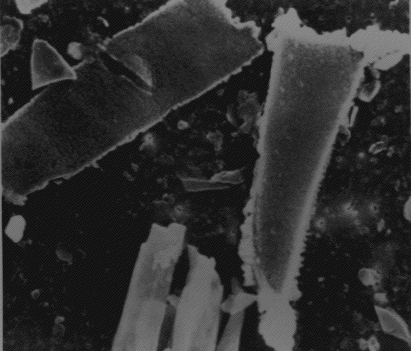
Comparison of particle sizes:
Substance Micro-meters (microns) Inch
90% of Wood smoke
particles are
smaller than 1 micron 0.00004
Bacteria (average) 2 0.00008
Red Blood Cell 8 0.0003
Talcum Powder 10 0.0004
White Blood Cell 25 0.001
Human Hair 70 0.003
Grain of Table Salt 100 0.004
The American Lung Association says:
More than 90% of the woodsmoke particle mass consists of fine particles, the fraction of pm that many researchers consider to have the greatest association with adverse health outcomes. in addition to fine pm, woodsmoke emissions contain components such as carbon monoxide (an asphyxiant), various irritant gases such as nitrogen dioxide, sulfur dioxide, hydrochloric acid, and aldehydes such as formaldehyde and acrolein, and chemicals known or suspected to be carcinogens, such as polycyclic aromatic hydrocarbons (pahs), oxygenated pahs, and polychlorinated dioxins and furans.
Findings from animal toxicological studies demonstrate a reduction in pulmonary anti-bacterial defense mechanisms associated with woodsmoke exposure. woodsmoke exposure can disrupt cellular membranes, depress macrophage activity, destroy ciliated and secretory epithelial cells and cause aberrations in biochemical enzyme levels.
A large body of evidence links PM with adverse health outcomes, including excess cardiopulmonary illness.
Epidemiological studies show a coherence of data among studies of health consequences for those exposed to woodsmoke. persons at higher risk include young children, the elderly, and people with preexisting cardiopulmonary disease. demonstrated effects include increased pulmonary symptoms, increased hospital admissions for lower respiratory infections, exacerbation of asthma, and decreased pulmonary function in school-age children.
Carcinogenic substances – some of the carcinogenic substances identified in wood smoke include aldehydes and polycyclic aromatic hydrocarbons and dioxins.
The following information is published on the EPA Tasmania – Air website:
Further information:
If wood is burned properly, the only products that will be formed are a gas called carbon dioxide, some water which comes off as steam and a small amount of ash, which cannot burn. However, often the wood does not burn completely and it can make a lot of smoke with hundreds of different chemicals, called “products of incomplete combustion”.
Types of Air Pollutants
We can put these many different chemicals into groups of similarity called classes. Scientists know that some of these chemicals can cause problems for people, like causing disease in their lungs or heart, or making their illness worse if they are already sick. However, there are a number of chemicals Scientists still hardly know anything about their affect on human health and research is being done to try and find out. Some of the chemicals are gases, some are liquids and others are solids. When there is more of a chemical mixed into the air than is good for us, we call it a pollutant.
Concentration is the word we use to describe how much of a pollutant is mixed with the air. There are two main ways, called “units”, that we use to describe concentration.
For particles, we use “micrograms per cubic metre”, written as “1 µg/ m3”. If you read further down, you will see a description of particles, or particulate matter.
If you imagine a large cardboard box that is one metre high, one metre wide and one metre deep, it will contain one cubic metre of air. It is written as “m3”. This is called the “volume” of air. One microgram is one millionth of a gram. This is very tiny amount, but still large enough for us to measure. We shorten this to “1 µg”, where the Greek letter “µ” means “millionths of”, and “g” means “gram”. So a concentration of one microgram of smoke per cubic metre means that there is one millionth of a gram of smoke in each cubic metre of air, and we write it as “1 µg/ m3”.
For gases, we use another unit, called “parts-per-million”, written as “ppm”. This is a little harder to explain. There are several gases described lower down on this page. For example, carbon monoxide is a gas that often occurs in air.
Imagine the same large cardboard box that you did before, containing a volume of one cubic metre of air. If we take a tiny box that has a volume of one cubic centimetre of carbon monoxide and add it to the air in our box, we make a concentration of 1 part-per-million of carbon monoxide in air, which is shortened to “1 ppm”.
Chemicals from Wood Burning:
Some types of chemicals that come from burning wood are:
Carbon dioxide is a gas that we cannot see or smell. It is given off whenever anything that contains carbon in its chemical structure is burned completely, along with water. It is not dangerous to us in open air but it can asphyxiate us if there is too much of it in a small space. In other words, it prevents us from getting enough oxygen from the air to keep us alive. It is also what we call a greenhouse gas, which may be causing the earth to warm up.
Carbon dioxide stays in the air for a century, some of it into the thousands of years. And the world carbon dioxide pollution levels are accelerating yearly. Every second, the world’s smokestacks and cars pump 2.4 million pounds of the heat-trapping gas into the air.
–James Buttler, Director of global monitoring at the National Oceanic and Atmospheric Administration, Boulder,Colo.
Carbon monoxide is a gas that we cannot see, smell or taste. At very high concentrations, it is very poisonous, because it makes it very difficult for our blood to take oxygen from our lungs around to all the different parts of our bodies. However, luckily it is very unusual to get much carbon monoxide in the outside air, except where there are many cars and trucks on busy roads, especially if they are stuck in a traffic jam. Even then, people need to be exposed for some time at the kinds of levels found in city streets, because it takes time for carbon monoxide to build up in our bloodstream. So At lower concentrations in air, carbon monoxide can affect people with heart disease, because it makes their heart work harder to transport oxygen around their bodies. It has an Air Quality Standard of 9 ppm over 8 hours
Nitrogen oxides can be made by fire, either because the fuels used contain chemicals with nitrogen in them, or because the fire is so hot that a small amount of nitrogen from the air combines with oxygen to form them. For example, a gas flame will often make nitrogen oxides because it is very hot. Nitrogen oxides are also made by burning fuels like petrol and diesel in the engines of cars and trucks. There are two main types made by burning: nitric oxide (NO) and nitrogen dioxide (NO2), although there are some others that may be made in smaller amounts. Nitrogen dioxide may also come from some industrial factories that make a powerful acid called nitric acid, factories that galvanise steel (coat it with zinc) and others that make glass or power stations that generate electricity.
Nitrogen dioxide has more effects on our health than nitric oxide. It can irritate our lungs and cause bronchitis and other lung diseases. Over a long time, it can cause scarring of the very delicate air spaces in our lungs and reduce the amount of oxygen that they can absorb into the blood. Because of its health effects, there is an air quality standard of 0.16 ppm for an hour.
Webmaster’s comment: The lifetime of PM 10 is from minutes to hours and its travel distance varies from less than a kilometer to 100 kilometers (NRDC, 1996).
The lifetime of PM 2.5 is from days to weeks and their travel distance ranges from 100 to greater than 1000 kilometres (NRDC, 2000)
Wood smoke has a PM2.5 signature
When we speak of air pollution, particles are simply small materials that can be suspended or will float in the air. Particles can be quite large (PM10’s) like sand blown from the desert on this site’s home page, or may be too small for us to see without a microscope. A large collection of particles is called particulate material or sometimes just particulates.
Most of the particles that we find in our cities are small and very complicated mixtures of many different things. They include:
Dust blown by the wind from soil, or stockpiles of building materials, or industrial raw materials and products, or sometime just from the trucks that drive over dusty roads;
Smoke from burning wood, oil, waste materials, or even gas; Pollen grains, bacteria, fungal spores, dust from wheat, barley and other cereals, tiny pieces of skin from animals;
Dusts and fumes from chemical processes, welding, painting, gritblast cleaning and other industrial processes.
Fog, mist and “smog”, which are really tiny droplets of liquid and sometimes solid particles, formed by natural processes in the atmosphere – sometimes called aerosols.
This is a very large group of chemicals that contains many hundreds of chemicals of many different classes. However, they are all chemicals that contain carbon. The word Volatile in their name simply means that they evaporate easily, like water does when it dries in the sun. Some may contain carbon and hydrogen only. Others may have carbon, hydrogen and oxygen, while some may also have other elements like sulphur or nitrogen in their molecules. Because there are so many different types, the effects of every one of them on our health may be different and are not always understood. Also, many of these chemicals help form a type of pollution called photochemical smog, in which ozone is formed, and is found in some large cities, such as Sydney and Melbourne. We do not believe that this type of smog pollution is a problem in Tasmania.
There are many different types of aldehydes, many of which are poisonous or can irritate our eyes, nose and lungs, or are just plain smelly. Two such aldehydes are acrolein and formaldehyde. They may be in the air as gases, or mixed with particulate material.
Acrolein irritates our eyes, nose and our lungs, and is a special problem for some people who have asthma or bronchitis. It is often a product of burning wood but acrolein can also be made when fat burns, as happens on a charcoal barbecue when fat from the chops and sausages drips on to the hot beads.
Formaldehyde also irritates our eyes, nose and lungs and may cause cancer in some people. It comes from burning materials containing carbon but is also commonly used to make some types of special glues for making boats and in making particle boards for floors and walls. Therefore, it may be found in the air near factories that make such products. It is also used for making several types of plastics, such as “Bakelite” and laminates that are used on kitchen tables and benches. Formaldehyde can also come from gas stoves, or kerosene/oil/gas space heaters which do not have flues going outside the house. In many cases, formaldehyde concentrations may be much higher inside a house than outside. Some people can become very sensitive to formaldehyde so that very tiny amounts can make them sick.
https://cleantechnica.com/2022/04/16/a-win-for-science-epa-releases-formaldehyde-study-the-chemical-industry-tried-to-suppress/?fbclid=IwAR2POjzFRIV2JVYqgGBVLoO5NBwdYQE3Ls_rrKoJZxUoHiW0r87DwVhy7tA
Benzene, toluene and xylenes are chemicals that are also called aromatic compounds, because they have a strong smell. They are often found in car exhaust gases, from cars or trucks burning petrol or diesel fuels but may also be made when other carbon-containing materials like wood or oil are not burned properly. They all cause irritation to our eyes and nose and sometimes our lungs. At the levels usually found in ambient air, they are also known to have long-term effects on people’s nervous systems. BTX are included in the new Air Toxic NEPM made in 2004. (See the Environment Protection and Heritage Council web site for details: National Environment Protection Measure on Air Toxics
Benzene is probably the worst of them, because it is very poisonous, affecting people’s livers and nervous systems. It probably also causes cancer. For these reasons, it has been removed from petrol, so it is much less of a problem than it was a few years ago. However, it is still made in car engines and comes out in the exhaust gases.
Toluene is not so poisonous as benzene, but is still a pollutant that comes from car exhausts. It is also found in smoke from fires and some other processes.
Xylenes (there are three of them) are often found in special paint thinners and brush-cleaning solvents or paint strippers. They are also made in car engines and wood fires. They are very irritating to our eyes, nose and lungs.
Polynuclear aromatic hydrocarbons are a group of chemicals that are usually formed when materials containing carbon are burned very badly. We find them in black smoke, soot and tar from burning coal, wood, heavy oil, and other things like plastic, if there has not been enough air to burn them properly. They can also be formed when we burn our toast at breakfast. They are quite complicated chemicals that do not evaporate easily, so they are often found sticking to particles of carbon. If the particles are small enough, they will get right down into the deepest parts of the lungs and may cause disease, including cancer. We have known for a long time that one of them, called benzo(a)pyrene, can cause cancer. In the old days, chimneysweeps sometimes developed cancer due to benzo(a)pyrene in the soot that covered them every day as they worked. Benzo(a)pyrene is also included in the new Air Toxics NEPM
“To evaluate lung toxicity….in terms of the mass of fuel consumed smoldering eucalyptus demonstrated the greatest lung toxicity of all the fuels tested.
…smoke from flaming eucalyptus and peat was the most toxic to the lungs.”
North Pole Clean Air – Summary of the toxic chemical agents found in wood smoke
Read the latest harmful findings:
2010 – Final Review paper for the Ambient Air Quality NEPM
May 2010 – I received the following disturbing email…
The smoke in the Tamar valley, today is terrible. Yesterday it was bad enough, I had runny eyes etc, today I am having to constantly use my ventolin just to be able to take a breathe without coughing.
Do you have any suggestions as to who I can complain to? I looked up the complaints form for the FPA and they want details as to where the smoke is coming from and I don’t know.
There is a large pool of smoke coming up from the South West and there has been a lot of smoke coming up from the North/ North East over the last two days (blotting out Mt Arthur, particularly late in the afternoon, from my place in XXXX). The hills are just white.
Here’s hoping you have some suggestions for me…..,
I replied and here was an even more disturbing response from this distressed person…
…when I came home again it had cleared considerably. But the way things are going with forestry, I think I will have many more chances to report to them when my health is affected. I don’t go to the doctor very often as it costs me almost $30 a time to go and see him after medicare rebate (I’m an aged pensioner)
EPA NSW – Air – Health Implications:
“An increasing range of adverse health effects has been linked to air pollution, especially particulate matter.
Short-term exposure exacerbates existing respiratory and cardiovascular symptoms and increases the risk of symptoms, hospitalisation, and death. Long-term exposure increases the risk of chronic respiratory and cardiovascular disease and death, impacts on birth weight, and can permanently affect the lung development of children”. http://www.environment.nsw.gov.au/resources/air/actionforair/09712ExecutiveSummary.pdf
EPA South Australia:
“Common effects of air pollution include changes in heart and lung functions with increases in associated medical conditions such as asthma, bronchitis, and heart disease. Air pollution also contains compounds which can affect the nervous system and are carcinogenic.
Some research has found that the adverse health effects of air pollution has a real cost to the community through increased hospital admissions and premature deaths”.
http://www.epa.sa.gov.au/environmental_info/air_quality/air_quality_and_health
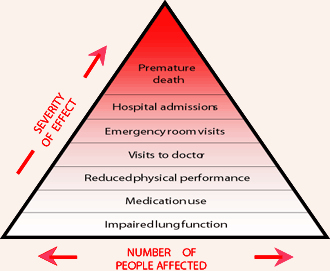
Air Pollution Health Effect Pyramid
Natural Sources of Canada
Australian Child Health and Air Pollution Study. (ACHAPS) Final Report - May 2012.
COPD vs. Emphysema: What’s the Difference?
Symptoms tend to worsen over time, especially if exposure to smoke is not eliminated.
STOP PRESS – October 17, 2013
World Health Organisation (WHO) – latest findings.
Air pollution CAUSES cancer
And if you think this isn’t enough go here to the WHO Air Pollution Health Topic pages

Potential cancer sticks.
Think of others before you strike!
Even if you are healthy you can still be negatively affected by wood smoke causing you to feel lethargic and generally unwell
– WA Department of Environment and Conservation
“Air pollution in general is increasingly recognized as a systemic health threat, impairing the functioning of virtually every organ system.” – Read what the Utah Physicians for a Healthy Environment (UPHE) have to say.
This is what the Australian government has to say:
“…certain sensitive groups can experience more severe short-term and chronic effects. It appears that the same population groups that are susceptible to particles in cities are also susceptible to particles from biomass burning. These groups are: people with asthma and other respiratory disease, people with cardiovascular disease, children and the elderly. Pregnant women and unborn children are potentially susceptible, given that smoke from biomass burning contains many of the same compounds found in cigarette smoke.
The American Thoracic Society found, “… with an increase of 10 micrograms per cubic meter of particles over two years, the risk of dying was increased by 32% for people with diabetes, 28% for people with COPD, asthma and pneumonia, 27% for people with congestive heart failure and 22% for people with inflammatory diseases.- Center for Disease Control: A Review of Factors Affecting the Human Health Impacts of Air Pollutants From Forest Fires. Division of Environmental Hazards and Health Effects National Center for Environmental Health. www.forestencyclopedia.net/p/p819
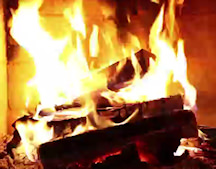
This commercial explains in 30 sec. why heating your home with wood is one of the worst things you can do for your own health.
From Utah Physicians for a Healthy Environment Click on the image above.
